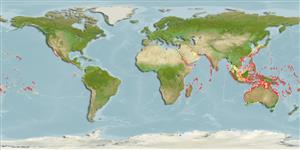分類 / Names
俗名 | 同種異名 | Catalog of Fishes(屬, 種) | ITIS | CoL | WoRMS | Cloffa
Teleostei >
Gobiiformes (Gobies)
鱸形目 (Gobies) >
Gobiidae (Gobies)
鰕虎魚科 (Gobies) > Gobionellinae
Etymology: Gnatholepis: Greek, gnathos = jaw + Greek,lepis = scale (Ref. 45335).
More on author: Bleeker.
Environment: milieu / climate zone / depth range / distribution range
生態學
海洋; 半鹹淡水 礁區魚類; 深度上下限 1 - 46 m (Ref. 11441). 熱帶
Indo-Pacific: Persian Gulf (Ref.80050) and Red Sea and East Africa to the Hawaiian, Marquesan and Society islands.
印度-太平洋: 紅海而且東非到夏威夷,馬貴斯群島與社會群島。
大小 / 重量 / 年齡
Maturity: Lm ? range ? - ? cm
Max length : 8.4 cm SL 雄魚/尚未辨別雌雄; (Ref. 41653)
背棘 (總數): 6 - 7; 背的軟條 (總數): 11; 臀棘 1; 臀鰭軟條: 11. Distinguished by the following characteristics: ctenoid scales on head, predorsal midline and pectoral fin base, distinct flap present at end of lower lip; at least three dark spots along first spine of first and second dorsal fins, followed by at least three rows of dark spots or short streaks, pectoral fin with rows of fine dark and white speckles; second dorsal and anal fin rays nearly always I,11; pectoral rays 14-17, modally 16; lateral scales 25-29, modally 27; predorsal scales 7-13, usually 9-10, mostly ctenoid, may be cycloid anteriorly or toward midline; body compressed, width at anus 11.9-28.1% (mean 15.2%) of SL; body stocky in appearance, body depth at anus 19.6-26.6% of SL, body depth at first dorsal fin origin 14.3-27.7% of SL; head compressed, broader ventrally, slightly deeper than wide, HL 26.6-33.3% of SL; head depth at posterior preopercular margin 62.0-83.7% of HL; head width at posterior preopercular margin 53.7-82.2% of HL; head profile bluntly pointed; nape slightly convex behind eyes; mouth subterminal to nearly terminal, slightly oblique; jaws generally reaching to below anterior margin of eye; upper jaw length 32.0-41.5% of HL; upper lip smooth, narrower than lower, lower lip papillose close to teeth, with twist or fold posteriorly, forming triangular flap, lip interrupted at chin; eye moderate to relatively small in large specimens, dorsolateral, 22.7-30.5% of HL; preorbital width 18.2-27.8% of HL; snout bluntly pointed, 22.4-44.4% of HL; posterior naris round to almost triangular, close to anterior margin of eye; anterior naris in short tube, higher on posterior margin of eye, about level with middle of eye or somewhat ventral to it; interorbital narrow, 4.7-11.3% of HL; caudal peduncle compressed, length 12.9-18.6% (mean 16.1%) of SL; caudal peduncle depth 10.7-13.8% of SL (Ref. 92171).
身體有一系列的 6個細長垂直的暗色斑塊沿著身體的下側, 在形成一個從胸鰭的在下面上半部到尾鰭的基底中點的列的每個暗色的斑塊上具有一個水平的數列深褐色的點或者短的深褐色的線; 一系列的比較少量明顯的暗色斑塊在身體背面, 不和低的斑塊 , 與在暗色的斑塊上趨向形成群的很多的小深褐色的點成一直線。 [標本從西南太平洋與深色的棲息地, 例如在火山的沙子上, 在身體上可能有連續的黑色線條]. 一個大的深褐色的斑塊包含在胸鰭基底上面的一個小的鮮黃色的斑點。 在眼睛中央之下的在頰上的一條狹窄的﹐垂直的﹐和深褐色的到黑色的橫帶;(有時有 1 或 2 短的斜支流) 一條狹窄的黑色橫帶通常成一直線具有或者正好位於瞳孔的後緣前。 在鰓蓋上的一個斜的深色印記。 在第 6 到第 7個鰭條的水平在胸鰭基底上的一條暗色的斑紋而且延伸到鰭的近端部份。 背鰭與尾鰭鰭有很多的小褐色斑點。 在胸鰭上的第二背鰭鰭與有很多的深色點的每個在動脈之間薄膜上大的成魚有一個長的褐色條紋。 頰位於前深色的橫帶眼睛下面通常有一些小鱗片。 延伸至的腹鰭前的鱗片垂直的在前鰓蓋骨的後面邊緣。 嘴些微下方, 口裂些微斜。 在縱向的系列 30 中的鱗片. 橫跨的鱗片系列 9.5. 偽鰓絲狀突起 6.(參考文獻 41653)
Solitary or in loose groups in sand (Ref. 90102). Inhabits shallow coastal bays and estuaries on silty sandy substrates with sparse algae-reef or seagrasses (Ref. 48637). Benthic (Ref. 58302). Feeds on organic matter and small invertebrates (Ref. 89972).
棲息於珊瑚礁區域的砂質底部。
Life cycle and mating behavior
成熟度 | 繁殖 | 產卵場 | 卵 | 孕卵數 | 仔魚
Benthic spawner.印度-太平洋: 紅海而且東非到夏威夷,馬貴斯群島與社會群島。
Randall, J.E. and D.W. Greenfield, 2001. A preliminary review of the Indo-Pacific gobiid fishes of the genus Gnatholepis. Ichthyological Bulletin of the J.L.B. Smith Institute of Ichthyology, 69:1-17. (Ref. 41653)
人類使用
漁業: 低經濟
更多資訊
參考文獻養殖養殖資訊品種遺傳學Electrophoreses遺傳率疾病加工NutrientsMass conversion
合作者照片Stamps, Coins Misc.聲音神經毒速度泳型鰓區Otoliths腦重體重比眼睛色素
工具
特別的報告
下載 XML
網路資源
Estimates based on models
Preferred temperature (Ref.
123201): 24.3 - 29, mean 27.7 °C (based on 808 cells).
Phylogenetic diversity index (Ref.
82804): PD
50 = 0.5010 [Uniqueness, from 0.5 = low to 2.0 = high].
Bayesian length-weight: a=0.00977 (0.00442 - 0.02163), b=3.05 (2.86 - 3.24), in cm total length, based on LWR estimates for this (Sub)family-body shape (Ref.
93245).
營養階層 (Ref.
69278): 3.4 ±0.4 se; based on size and trophs of closest relatives
回復力 (Ref.
120179): 高度, 族群倍增時間少於 15個月 (Preliminary K or Fecundity.).
Fishing Vulnerability (Ref.
59153): Low vulnerability (10 of 100).
Nutrients (Ref.
124155): Calcium = 133 [66, 296] mg/100g; Iron = 0.882 [0.415, 1.694] mg/100g; Protein = 18.2 [16.2, 20.0] %; Omega3 = 0.155 [0.068, 0.290] g/100g; Selenium = 23.3 [11.6, 57.7] μg/100g; VitaminA = 117 [29, 421] μg/100g; Zinc = 2.85 [1.88, 4.34] mg/100g (wet weight);
